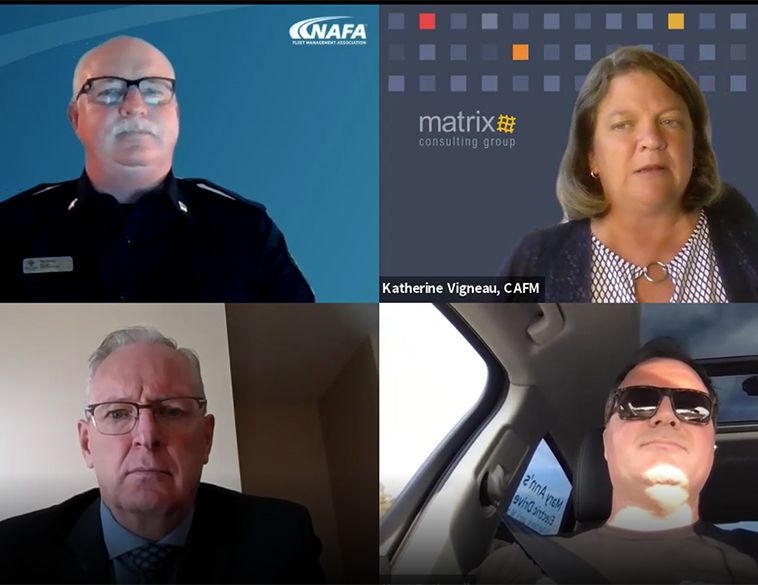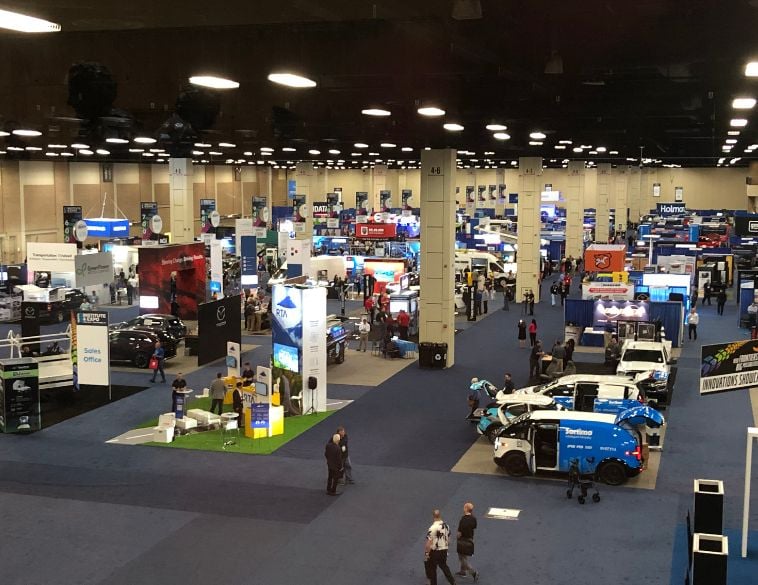Special Canadian session focused on delayed replacement, EV adoption and other key issues impacting the fleet management landscape.
From September 13-15, NAFA hosted its I&E Virtual Experience event.
For Canadian attendees, there were some specific workshops and information sessions that focused on experiences and issues North of the Border.
A Virtual Canadian Workshop on September 14, brought together noted experts on fleet management and infrastructure and featured current NAFA President Ray Brisby, CAFM, who also serves as Provincial Manager, EMS Fleet Operations for Alberta Health Services; Lloyd Brierly former Fleet Manager for the City of Toronto; Kent Rathwell, President, Sun Country Highway, plus Kate Vigneau CAFM, Director of Fleet and Government Services, Canada Matrix Consulting Group.
The Canadian workshop involved the panellists discussing a whole host of subjects at the top of mind for many fleet managers at present—these including the lingering impacts of COVID-19, delayed fleet replacement and EV adoption.
On the subject of COVID-19, the panellists agreed that in the past—as it relates to risk management and contingency planning—most of the emphasis was on natural disasters such as flooding and fire.
Therefore, when COVID-19 hit like a tsunami last year, it completely turned everything upside down.
New strategies
If anything, COVID has shown much of the world and many businesses new ways to improve efficiency and operations.
Lloyd Brierly noted that in many cases, having staff work from home has improved productivity, plus the widespread adoption of virtual training has allowed more people access to training and educational opportunities, saving time, money and ultimately boosting efficiency and staff productivity.
Yet he acknowledged, that as far as the pandemic is concerned, issues such as the cleaning and disinfecting of vehicles, solo occupancy and protective shields weren’t something that many fleets had really thought about prior to March 2020 and certainly wasn’t factored into their risk management and contingency plans.
Ray Brisby added that in many ways, COVID acted as a reset button; forcing many organizations, including fleets to get back to basics.
“One thing I noticed during COVID,” he said, “is that we really focused on core business services.”
This meant that a lot of extracurricular activities were moved further down the priority list.
An advantage of this was that it allowed Alberta Health Services to focus on some longstanding issues, including a renewed focus on Infection, Prevention and Control, since hygiene and cleanliness were a key part in helping mitigate the spread of the novel coronavirus.
While things have moved on since Spring 2020, the pandemic is still very much with us and a big concern revolves around vaccinations and whether or not they should be mandated.
Brisby acknowledged that vaccination is a touchy subject and that he can very much see two sides to it. He noted that as far as employees are concerned, there is still a great deal of angst regarding the vaccinations and potential mandates, not only for organizations themselves but also their vendors and suppliers.
Additionally, another challenge for fleets and other businesses is, once they look at starting to re-integrate staff into the workplace, just how much office space and how many workstations will be needed?
If there is excess capacity in the workspace, what do you do with it?
Brisby concurred with Brierly, that AHS, like many fleets, wasn’t prepared for something like the pandemic, since, for the longest time, it just wasn’t something many could predict would actually happen.
EV adoption
Shifting gears, another key topic for the panel discussion was EV adoption.
Kent Rathwell, whose company Sun Country Highway, has considerable experience in developing support and charging infrastructure for EVs, said that while political and media attention has lasered in on this topic over the last few years, challenges do remain.
At present, supply for EVs and indeed just about any type of vehicle is severely limited, hampered by semiconductor chip shortages and supply chain disruptions. Rathwell said that as far as EV adoption is concerned, the concept has taken some time among fleets.
Today, however, with consumer sentiment toward EVs increasing and OEMs committing to significantly ramp up EV production over the next few years, the case for fleets adopting them is becoming stronger.
A key part in any successful EV uptake on the fleet side will revolve around the charging infrastructure that can support them and Rathwell discussed turnkey solutions that his company has been developing that can help, including infrastructure turnkey packages for municipal bus fleets.
Rathwell believes that in 2022, we will see a significant increase in EV adoption on the fleet side as it becomes easier to provide infrastructure options that support them.
Delayed replacement
On the subject of delayed replacement; Kate Vigneau asked that, given the current difficulties in being able to obtain new vehicles, are there any benefits to delayed replacement?
Ray Brisby explained that while logic might dictate that replacing older vehicles with newer ones would seem to boost efficiency and cost savings, that isn’t always the case.
For fleets that require specialized vehicles, the cost of replacement means that in many cases, these fleets will want to maximize the lifecycle as well as the utilization of their assets.
When it comes to delaying replacement, one way that fleets can manage this is by moving assets around, switching underutilized vehicles with those that are heavily used.
Brisby said it was one tactic he employed during his time with the City of Calgary Fire Department and has since been used while managing the EMS fleet in the city as well.
He said that longer-term, it’s not a strategy that’s necessarily advisable, but when dealing with short-term issues such as the current lack of new vehicle inventory, it can be advantageous, provided it is done carefully and the fleet has a solid preventative maintenance (PM) plan in place.
Kate Vigneau mentioned that when it comes to delayed replacement, greater fuel costs tend to be a negative factor that’s often considered, as in theory, the argument is that newer vehicles tend to be more fuel-efficient than the older ones.
Yet she acknowledged that in discussions, this isn’t always the case and Ray Brisby also concurred. He said in some cases, new vehicles on order actually can deliver less fuel economy than the units they replace, but he said, when it comes to assessing the total cost spectrum of the vehicle’s life cycle, “fuel costs are probably going to be a negligible portion of it.”
Instead, a bigger consideration should be maintenance and downtime, which if not handled properly can really eat into operational costs.
Lloyd Brierly noted that when it comes to preventative maintenance and fleet utilization efficiency, being able to fine-tune it to drive more efficiency across the fleet can be beneficial.
Like Brisby, he stressed the importance of identifying which assets are being under-utilized and those which are seeing much greater usage and switch them around, though he cautioned, fleet managers might get resistance from some drivers, who can become attached to the vehicles they operate regularly.
Brierly did say that as a general rule of thumb, the older a vehicle is, the more it tends to cost from a maintenance standpoint and during his time at the City of Toronto, even when it came to fuel, the fleet factored in a degradation rate of 2% per year.
Takeaways
In summarizing the Canadian Workshop, each of the panellists was asked to present a challenge to the audience on ways to improve their fleet operations in 2021 and into 2022.
Lloyd Brierly suggested focusing on mobility as a service and creating a more cooperative ownership model that enables improved utilization, as well as reducing capital costs and making better use of existing funding.
Additionally, he stressed that a cooperative approach can also enable fleet managers to leverage more buying power and achieve greater economies of scale.
Ray Brisby stressed the importance of investing in your people and encouraging younger individuals to join the industry by providing the opportunity to learn, grow and succeed in the fleet management industry.
Kate Vigneau emphasized the people aspect of the business too and also how associations like NAFA can be a great platform for networking and connecting with others in the industry who may be experiencing similar issues and how collectively, people can work together to solve them.
Kent Rathwell said that when it comes to EV adoption, simply taking the first step to learning more and trying out EVs in person is essential.
“Stretch your comfort zone and take action, it starts with little steps,” he said. Rathwell also remarked that when it comes to new technology; being a champion for it and leading the way can help galvanize others into action and is, often, the best recipe to creating real, positive change.



